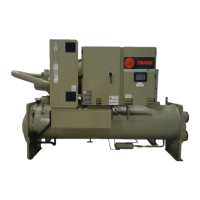RTHD-SVX01L-EN
53
Start-Up and Shutdown
Important: Initial unit commissioning start-up must be
performed by Trane or an agent of Trane
specifically authorized to perform start-up and
warranty of Trane products. Contractor shall
provide Trane (or an agent of Trane
specifically authorized to perform start-up) with
notice of the scheduled start-up at least two
weeks prior to the scheduled start-up.
Unit Start-Up
NOTICE
Equipment Damage!
Failure to follow instructions could result in
equipment damage.
Ensure that the compressor and oil sump heaters
have been operating properly for a minimum of 24
hours before starting.
If required, once the system has been operating for
approximately 30 minutes and has become stabilized,
complete the remaining start-up procedures, as follows:
1. Check evaporator and condenser refrigerant pressures
under Status Report on the Tracer TU or AdaptiView™
TD7. The pressures are referenced to sea level
(14.6960 psia).
2. Check EXV sight glasses after sufficient time has
elapsed to stabilize the chiller. The refrigerant flow past
sight glasses should be clear. Bubbles in the refrigerant
indicate either low refrigerant charge or excessive
pressure drop in the liquid line or a stuck open
expansion valve. A restriction in the line can sometimes
be identified by a noticeable temperature differential
between the two sides of the restriction. Frost will often
form on the line at this point. See “Unit Description,” p.
10 for proper refrigerant charges.
Important: A clear sight glass alone does not mean that
the system is properly charged. Also check
system subcooling, liquid level control and unit
operating pressures.
If chiller is limited by any limiting conditions, contact local
Trane service organization for more information.
Temporary Shutdown and
Restart
To shut down for a short time, use the following procedure:
1. Press the STOP key on the Adaptiview TD7. The
compressors will continue to operate and an
operational pumpdown cycle will be initiated.
2. Symbio™ 800 pump control will turn off the pump (after
a minimum 1 min. delay) when the STOP key is
pressed and automatically restart the pump when the
unit starts normally.
3. The unit will start normally, provided the following
conditions exist:
a. The Symbio 800 receives a call for cooling and the
differential-to-start is above the setpoint.
b. All system operating interlocks and safety circuits
are satisfied.
Extended Unit Shutdown
1. Perform the normal unit stop sequence using the
<Stop> button on the TD7 Touchscreen.
Note: Do not open starter disconnect switch. This must
remain closed to provide control power from the
control power transformer to the oil sump heater.
2. Verify chilled water and condenser water pumps are
cycled off. If desired, open disconnect switches to the
pumps.
3. Drain condenser piping and cooling tower, if desired.
4. Remove the drain and vent plugs from the condenser
headers to drain the condenser.
5. Verify that the Crank Case heater is working.
6. Once the unit is secured, perform the maintenance
identified in the following sections.
Seasonal Unit Start-Up
Procedure
1. Close all valves and re-install the drain plugs in the
evaporator and condenser heads.
2. Service the auxiliary equipment according to the
startup/ maintenance instructions provided by the
respective equipment manufacturers.
3. Vent and fill the cooling tower, if used, as well as the
condenser and piping. At this point, all air must be
removed from the system (including each pass). Close
the vents in the evaporator chilled water circuits.
4. Open all valves in the evaporator chilled water circuits.
5. If the evaporator was previously drained, vent and fill
the evaporator and chilled water circuit. When all air is
removed from the system (including each pass), install
the vent plugs in the evaporator water boxes.
NOTICE
Equipment Damage!
Failure to follow instructions could result in
equipment damage.
Ensure that the compressor and oil sump heaters
have been operating properly for a minimum of 24
hours before starting.
6. Check the adjustment and operation of each safety and
operating control.

